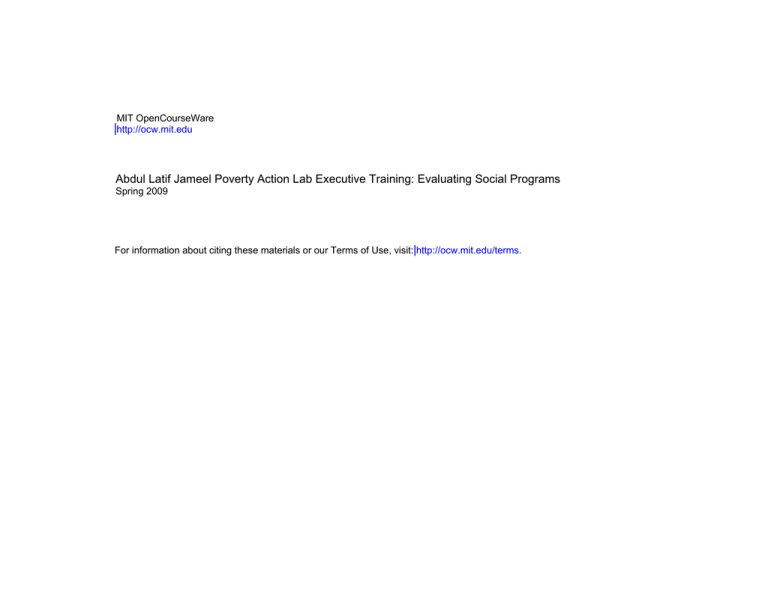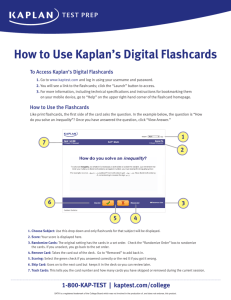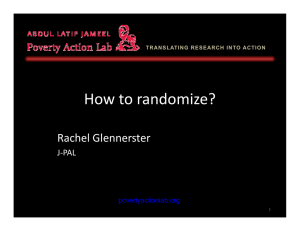Abdul Latif Jameel Poverty Action Lab Executive Training: Evaluating Social... MIT OpenCourseWare Spring 2009
advertisement

MIT OpenCourseWare http://ocw.mit.edu Abdul Latif Jameel Poverty Action Lab Executive Training: Evaluating Social Programs Spring 2009 For information about citing these materials or our Terms of Use, visit: http://ocw.mit.edu/terms. How to randomize? Abdul Latif Jameel Poverty Action Lab povertyactionlab.org Outline I. Methods of randomization II. Gathering support for evaluation III. “Typical” plan How to Randomize, Part I - 1 Good evaluation is not just “How did we do?” Also “How should we do it?” • Key component: Identify implementers’ questions • Answer them Make research a win-win for operations How to Randomize, Part I - 2 Outline I. Methods of randomization a. b. c. d. Basic Lottery Phase-in Rotation Encouragement II. Gathering support for evaluation III. “Typical” plan How to Randomize, Part I - 3 Methods of randomization - overview Design Most useful when Advantages Basic lottery Program oversubscribed OK for some to get nothing Familiar Easy to understand Easy to implement Can be implemented in public Phase in Expanding over time Easy to understand Everyone must receive treatment eventually Rotation Encouragement Everyone must get something at some point, not enough resources a year for all Constraint easy to explain Control comply as expect to benefit later More data points than phase in Disadvantages Control group may not cooperate Differential attrition Anticipation of treatment may impact short run behavior Difficult to measure long term impact Difficult to measure long term Can randomize at individual level even Measures impact of those who Program has to be open to all comers when program isn't respond to the incentive When take up in general is low but can be impacted with incentive easily. Need big enough enducement to get change in take up Encouragement may have direct effect How to Randomize, Part I - 4 Lottery: Start with clinical trial benchmark • Take 1000 people and give half of them the drug • Can we simply apply this approach to social programs? How to Randomize, Part I - 5 What are the constraints when we randomize in social situations? • Cannot interfere significantly with program operations • Must be perceived as fair • Must be politically feasible • Must be ethical How to Randomize, Part I - 6 Oversubscription or “Why resource constraints are an evaluator’s best friend” • Many programs have limited resources • Many more eligible recipients than resources will allow services for • Quite common in practice: – Training for entrepreneurs or farmers – School vouchers How do you allocate these resources? How to Randomize, Part I - 7 Lotteries are simple, common and transparent • Randomly chosen from applicant pool • Participants know the “winners” and “losers” • Simple lottery is useful when there is no a priori reason to discriminate • Perceived as fair • Transparent • Often politically feasible How to Randomize, Part I - 8 … and flexible • When: Target the interested or the qualified? • At what level: Individuals or groups? – Microcredit borrowers, groups or branches – Over communities: which villages should we enter? – Over schools (e.g., the balsakhi program) • The extent: full or partial – Built in and “optimizing” operations (e.g., credit scoring in South Africa) How to Randomize, Part I - 9 What if you have 500 applicants for 500 slots? Consider non-standard lottery designs • Could increase outreach activities • Is this ethical? • Consider carefully what you are trying to evaluate – Would you evaluate the program if it never grew beyond these original 500 applicants? How to Randomize, Part I - 10 Sometimes screening matters • Suppose there are 2000 applicants • Screening of applications produces 500 “worthy” candidates • There are 500 slots • A simple lottery will not work What are our options? How to Randomize, Part I - 11 Consider the screening rules • What are they screening for? • Which elements are essential? • Selection procedures may exist only to reduce eligible candidates in order to meet a capacity constraint How to Randomize, Part I - 12 When screening matters: Partial Lottery • Program officers can maintain discretion – “Worthy” individuals are selected – Others are allocated slots via lottery • Example: Training program – – – – 2000 candidates 1000 meet key criteria: poor enough to qualify 250 out of 1000 chosen based on particular attributes NGO allocates remaining 250 slots by lottery • Example: Expansion of consumer credit in South Africa – Top applicants were all selected – Below a certain cutoff, all were rejected – Between the two, credit was randomly assigned How to Randomize, Part I - 13 Sometimes exclusion is not desirable Consider other points of interaction • Programs expand • They also have initial stages Think creatively about when to randomize How to Randomize, Part I - 14 Phase-in: takes advantage of expansion • Everyone gets program eventually • Natural approach when expanding program faces resource constraints – “In five years, we will cover 500 schools” • What determines which schools, branches, etc. will be covered in which year? – Some choices based on need, geography, etc. – Others largely arbitrary Can randomize order of phase-in How to Randomize, Part I - 15 Phase-in designs Advantages • Everyone gets something eventually • Provides incentives to maintain contact Concerns • Can complicate estimating long-run effects • Care required with phase-in windows • Do expectations of change actions today? How to Randomize, Part I - 16 Rotation design • Groups get treatment in turns • Group A gets treatment in first period • Group B gets treatment in second period Advantages • Perceived as fairer; easier to get accepted Concerns • If people in Group B anticipate they’ll receive the treatment the next period, they can have a different behavior in the first period • Impossible to measure long-term impact since no control group after first period How to Randomize, Part I - 17 When program benefits are necessary to ensure cooperation of control groups • Phase-in may not provide enough benefit to late round participants • Cooperation from control group may be critical Consider within-group randomization • E.g., balsakhi program • All participants get some benefit • Concern: increased likelihood of contamination How to Randomize, Part I - 18 Encouragement design: What to do when you can’t randomize access • Sometimes it’s practically or ethically impossible to randomize program access – Flu vaccines. Employee savings programs. • But most programs have less than 100% take-up • Randomize encouragement to receive treatment How to Randomize, Part I - 19 What is “encouragement”? • Something that makes some folks more likely to use program than others • Not itself a “treatment” – Bad idea: Training as encouragement for credit – Good idea: Marketing efforts • For whom are we estimating the treatment effect? • Think about who responds to encouragement – Are they different from whole population How to Randomize, Part I - 20 Multiple treatments • Sometimes core question is deciding among different possible interventions • You can randomize these programs • Does this teach us about the benefit of any one intervention? • Do you have a control group? • Advantage: win-win for operations, can help answer questions for them, beyond simple “impact”! How to Randomize, Part I - 21 Randomization in “the bubble” • Sometimes a partner may not be willing to randomize among eligible people. • Partner might be willing to randomize in “the bubble.” • People “in the bubble” are people who are borderline in terms of eligibility – Just above the threshold not eligible, but almost • What treatment effect do we measure? What does it mean for external validity? How to Randomize, Part I - 22 To summarize: Possible designs • • • • • • • Simple lottery Partial lottery with screening Randomized phase-in Rotation Encouragement design Multiple treatments Randomization in the “bubble” – Note: These are not mutually exclusive. How to Randomize, Part I - 23 Outline I. Methods of randomization II. Gathering support for evaluation a. b. Political: Gossip, Fairness and Ethics Administrative: Cost and Timing III. “Typical” plan How to Randomize, Part I - 24 Getting started “But I already know the answer… … and I don’t want to risk learning that we do not have an impact.” • • • • Listen Consider others’ perspectives & objectives Find ways to make research operationally useful Everyone should have interest in successful evaluation, not necessarily favorable evaluation How to Randomize, Part I - 25 Address specific concerns • • • • • • Gossip and individual perceptions Fairness Ethics Cost Incentives Timing How to Randomize, Part I - 26 Gossip: People will talk • The control group will find out about the treatment • You can take steps to minimize this (grouping, etc.) but it will happen • This can be good: everyone wants word-ofmouth advertising • But be mindful of impact – Set up experiment to measure this effect • Often a key concern for partners How to Randomize, Part I - 27 Fairness • Rare is the case of unlimited resources • When resources limited, “fairness” is in the framing: – Provide everyone with 50% of treatment – Provide treatment first-come, first-served: the first 50 have 100% probability of treatment; the rest 0% • Randomization can help learn more about target participants How to Randomize, Part I - 28 Ethics It’s wrong to use people as guinea pigs If it works, then it’s wrong not to treat everyone Some answers • Why are prescription drugs different? • All limited initiatives in some way an ‘experiment’ – Here, we control the experiment to learn & improve • Allocation of limited resources happens somehow – Why not learn while we are doing it? – Produce a public good for future generations. How to Randomize, Part I - 29 Cost • What is the cost of getting it wrong? • Often cheaper than non-experimental evaluations – Which costs more for survey work? – Which has more downside risk by yielding imprecise or biased results? – Key question is not ex post versus randomized trial, but evaluation vs. no evaluation Almost certainly cheaper when benefits included How to Randomize, Part I - 30 Timing • Almost all incremental work for a randomized evaluation happens up front • Projects usually want to happen “yesterday” • Begin thinking about evaluation concurrent with thinking about project How to Randomize, Part I - 31 Outline I. Methods of randomization II. Gathering support for evaluation III. “Typical” plan How to Randomize, Part I - 32 Randomization timeline Plan Pilot Implement How to Randomize, Part I - 33 Plan 1. 2. 3. 4. 5. Pilot Implement Identify problem and proposed solution Identify key players Identify key operations questions to include in study Design randomization strategy Define data collection plan How to Randomize, Part I - 34 Plan Pilot Implement 1. Identify problem and proposed solution • Define the problem (which should lead to the key hypotheses) • Define the intervention (sometimes already established) • Learn key “hurdles” in design of operations (maybe opportunity to help answer them) How to Randomize, Part I - 35 Plan 2. • • • Pilot Implement Identify key players Top management Field staff Donors How to Randomize, Part I - 36 Plan 3. • • • • Pilot Implement Identify key operations questions to include in study Find win-win opportunities for operations How to best market? How to sustain the program? – Pricing policy – Generating demand through spillovers Types or extent of training? How to Randomize, Part I - 37 Plan Pilot Implement 4. Design randomization strategy More on this later today – – – – Basic strategy Sample frame Unit of randomization Stratification 5. Define data collection plan More on this tomorrow How to Randomize, Part I - 38 Plan • • • • • • Pilot Implement Pilots vary in size & rigor Pilots & qualitative steps are important Something always goes wrong Better to find this out before study begins Often discover other interesting questions when you see the program working Complements lessons from other studies How to Randomize, Part I - 39 Plan 1. 2. 3. 4. 5. 6. Pilot Implement Identify “target” population Collect baseline information (if applicable) Randomize Implement intervention to treatment group Measure outcomes Analyze & assess results How to Randomize, Part I - 40 Plan Pilot Implement 1. Identify actual “target” population More on this later today 2. Collect baseline data More on this later How to Randomize, Part I - 41 Plan Pilot Implement 3. Randomize More details later and in exercises • • • Real-time randomization (e.g., credit scoring) All-at-once randomization – All villages known up front Waves – Want to learn from one wave to the next – Expansion plans not well defined throughout country. Selected districts in each wave How to Randomize, Part I - 42 Plan Pilot Implement 4. Implement intervention to treatment groups • Internal controls are critical • Nothing worse than doing all this work, but not having control on the field! 5. • • • • Measure outcomes Common question: “How long should we wait?” No one-size-fits-all answer Operational considerations must be traded off Wait long enough for impacts to materialize, but not so long that the participants are hard to find. How to Randomize, Part I - 43 Plan Pilot Implement 6. Analyze & assess results More on this later • • Must follow through on promises to partners A little goodwill goes a long way How to Randomize, Part I - 44



